#humanoid automatons
Text

– Nina Varela, Crier's War
#book quote of the day#nina varela#criers war#enemies to lovers#revenge#sapphic#heartwarming#in love with the cover#fantasy#high fantasy#ya#romance#humanoid automatons#book quotes
25 notes
·
View notes
Text

Specific phobia moodboard!
Phobia #4: Automatonophobia
#phobias#specific fear#creepy aesthetic#automaton#humanoid#human-like figures#uncanny valley#nightmare animatronics#metropolis 1927#mannequin#puppets#ratafak plachta#creepy doll#wax figure#automatonophobia
42 notes
·
View notes
Photo
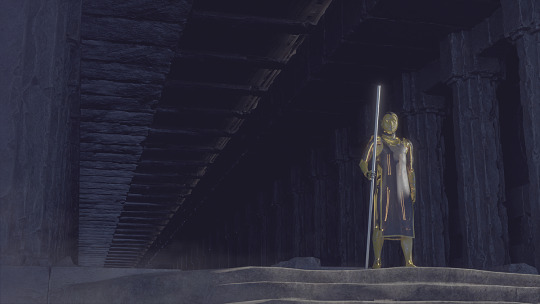
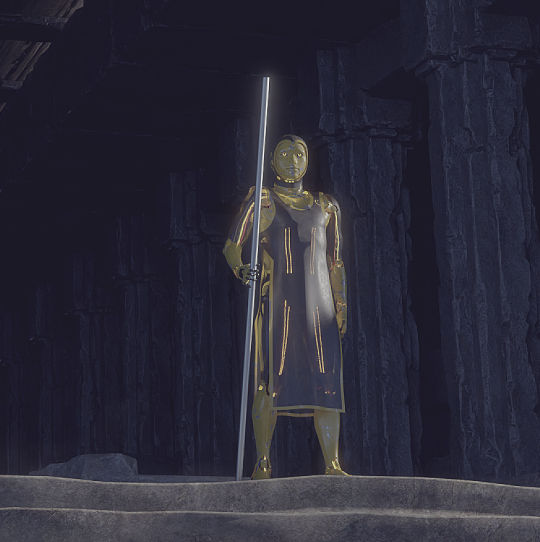
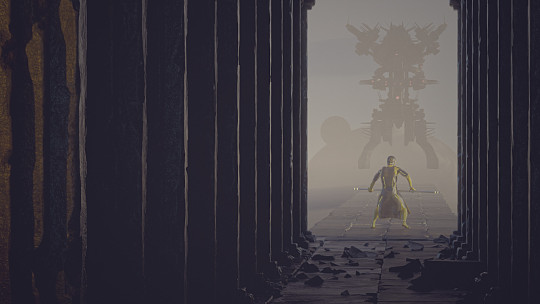
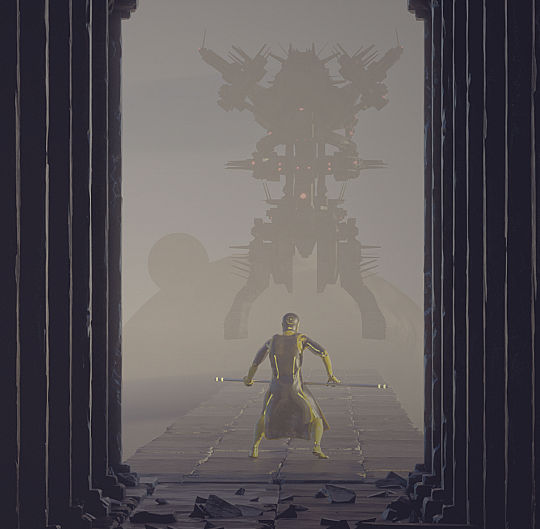

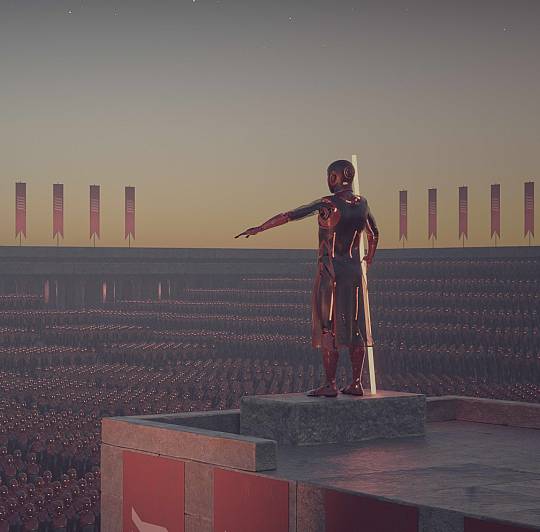
C E R B E R U S
Intended for book cover.
Cover design will be put out on tegnemaskin.no
#sci-fi#science fiction#guardian#fantasy art#temple#blender3d#3d artwork#automaton#Humanoid#robot#art#artist on tumblr
22 notes
·
View notes
Text
Three AI insights for hard-charging, future-oriented smartypantses
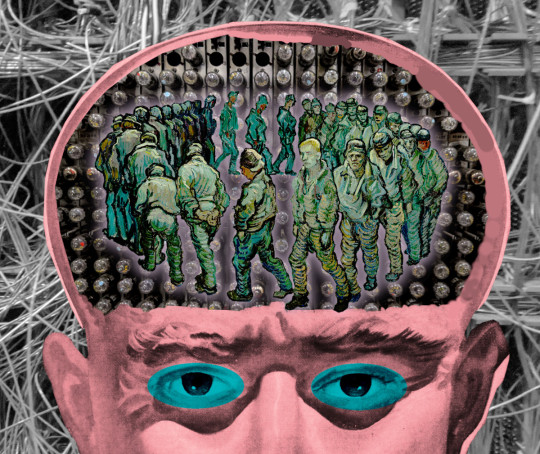
MERE HOURS REMAIN for the Kickstarter for the audiobook for The Bezzle, the sequel to Red Team Blues, narrated by @wilwheaton! You can pre-order the audiobook and ebook, DRM free, as well as the hardcover, signed or unsigned. There’s also bundles with Red Team Blues in ebook, audio or paperback.

Living in the age of AI hype makes demands on all of us to come up with smartypants prognostications about how AI is about to change everything forever, and wow, it's pretty amazing, huh?
AI pitchmen don't make it easy. They like to pile on the cognitive dissonance and demand that we all somehow resolve it. This is a thing cult leaders do, too – tell blatant and obvious lies to their followers. When a cult follower repeats the lie to others, they are demonstrating their loyalty, both to the leader and to themselves.
Over and over, the claims of AI pitchmen turn out to be blatant lies. This has been the case since at least the age of the Mechanical Turk, the 18th chess-playing automaton that was actually just a chess player crammed into the base of an elaborate puppet that was exhibited as an autonomous, intelligent robot.
The most prominent Mechanical Turk huckster is Elon Musk, who habitually, blatantly and repeatedly lies about AI. He's been promising "full self driving" Telsas in "one to two years" for more than a decade. Periodically, he'll "demonstrate" a car that's in full-self driving mode – which then turns out to be canned, recorded demo:
https://www.reuters.com/technology/tesla-video-promoting-self-driving-was-staged-engineer-testifies-2023-01-17/
Musk even trotted an autonomous, humanoid robot on-stage at an investor presentation, failing to mention that this mechanical marvel was just a person in a robot suit:
https://www.siliconrepublic.com/machines/elon-musk-tesla-robot-optimus-ai
Now, Musk has announced that his junk-science neural interface company, Neuralink, has made the leap to implanting neural interface chips in a human brain. As Joan Westenberg writes, the press have repeated this claim as presumptively true, despite its wild implausibility:
https://joanwestenberg.com/blog/elon-musk-lies
Neuralink, after all, is a company notorious for mutilating primates in pursuit of showy, meaningless demos:
https://www.wired.com/story/elon-musk-pcrm-neuralink-monkey-deaths/
I'm perfectly willing to believe that Musk would risk someone else's life to help him with this nonsense, because he doesn't see other people as real and deserving of compassion or empathy. But he's also profoundly lazy and is accustomed to a world that unquestioningly swallows his most outlandish pronouncements, so Occam's Razor dictates that the most likely explanation here is that he just made it up.
The odds that there's a human being beta-testing Musk's neural interface with the only brain they will ever have aren't zero. But I give it the same odds as the Raelians' claim to have cloned a human being:
https://edition.cnn.com/2003/ALLPOLITICS/01/03/cf.opinion.rael/
The human-in-a-robot-suit gambit is everywhere in AI hype. Cruise, GM's disgraced "robot taxi" company, had 1.5 remote operators for every one of the cars on the road. They used AI to replace a single, low-waged driver with 1.5 high-waged, specialized technicians. Truly, it was a marvel.
Globalization is key to maintaining the guy-in-a-robot-suit phenomenon. Globalization gives AI pitchmen access to millions of low-waged workers who can pretend to be software programs, allowing us to pretend to have transcended the capitalism's exploitation trap. This is also a very old pattern – just a couple decades after the Mechanical Turk toured Europe, Thomas Jefferson returned from the continent with the dumbwaiter. Jefferson refined and installed these marvels, announcing to his dinner guests that they allowed him to replace his "servants" (that is, his slaves). Dumbwaiters don't replace slaves, of course – they just keep them out of sight:
https://www.stuartmcmillen.com/blog/behind-the-dumbwaiter/
So much AI turns out to be low-waged people in a call center in the Global South pretending to be robots that Indian techies have a joke about it: "AI stands for 'absent Indian'":
https://pluralistic.net/2024/01/29/pay-no-attention/#to-the-little-man-behind-the-curtain
A reader wrote to me this week. They're a multi-decade veteran of Amazon who had a fascinating tale about the launch of Amazon Go, the "fully automated" Amazon retail outlets that let you wander around, pick up goods and walk out again, while AI-enabled cameras totted up the goods in your basket and charged your card for them.
According to this reader, the AI cameras didn't work any better than Tesla's full-self driving mode, and had to be backstopped by a minimum of three camera operators in an Indian call center, "so that there could be a quorum system for deciding on a customer's activity – three autopilots good, two autopilots bad."
Amazon got a ton of press from the launch of the Amazon Go stores. A lot of it was very favorable, of course: Mister Market is insatiably horny for firing human beings and replacing them with robots, so any announcement that you've got a human-replacing robot is a surefire way to make Line Go Up. But there was also plenty of critical press about this – pieces that took Amazon to task for replacing human beings with robots.
What was missing from the criticism? Articles that said that Amazon was probably lying about its robots, that it had replaced low-waged clerks in the USA with even-lower-waged camera-jockeys in India.
Which is a shame, because that criticism would have hit Amazon where it hurts, right there in the ole Line Go Up. Amazon's stock price boost off the back of the Amazon Go announcements represented the market's bet that Amazon would evert out of cyberspace and fill all of our physical retail corridors with monopolistic robot stores, moated with IP that prevented other retailers from similarly slashing their wage bills. That unbridgeable moat would guarantee Amazon generations of monopoly rents, which it would share with any shareholders who piled into the stock at that moment.
See the difference? Criticize Amazon for its devastatingly effective automation and you help Amazon sell stock to suckers, which makes Amazon executives richer. Criticize Amazon for lying about its automation, and you clobber the personal net worth of the executives who spun up this lie, because their portfolios are full of Amazon stock:
https://sts-news.medium.com/youre-doing-it-wrong-notes-on-criticism-and-technology-hype-18b08b4307e5
Amazon Go didn't go. The hundreds of Amazon Go stores we were promised never materialized. There's an embarrassing rump of 25 of these things still around, which will doubtless be quietly shuttered in the years to come. But Amazon Go wasn't a failure. It allowed its architects to pocket massive capital gains on the way to building generational wealth and establishing a new permanent aristocracy of habitual bullshitters dressed up as high-tech wizards.
"Wizard" is the right word for it. The high-tech sector pretends to be science fiction, but it's usually fantasy. For a generation, America's largest tech firms peddled the dream of imminently establishing colonies on distant worlds or even traveling to other solar systems, something that is still so far in our future that it might well never come to pass:
https://pluralistic.net/2024/01/09/astrobezzle/#send-robots-instead
During the Space Age, we got the same kind of performative bullshit. On The Well David Gans mentioned hearing a promo on SiriusXM for a radio show with "the first AI co-host." To this, Craig L Maudlin replied, "Reminds me of fins on automobiles."
Yup, that's exactly it. An AI radio co-host is to artificial intelligence as a Cadillac Eldorado Biaritz tail-fin is to interstellar rocketry.

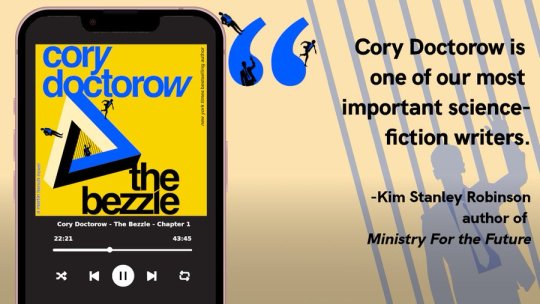
Back the Kickstarter for the audiobook of The Bezzle here!

If you’d like an essay-formatted version of this post to read or share, here’s a link to it on pluralistic.net, my surveillance-free, ad-free, tracker-free blog:
https://pluralistic.net/2024/01/31/neural-interface-beta-tester/#tailfins
#pluralistic#elon musk#neuralink#potemkin ai#neural interface beta-tester#full self driving#mechanical turks#ai#amazon#amazon go#clm#joan westenberg
1K notes
·
View notes
Photo
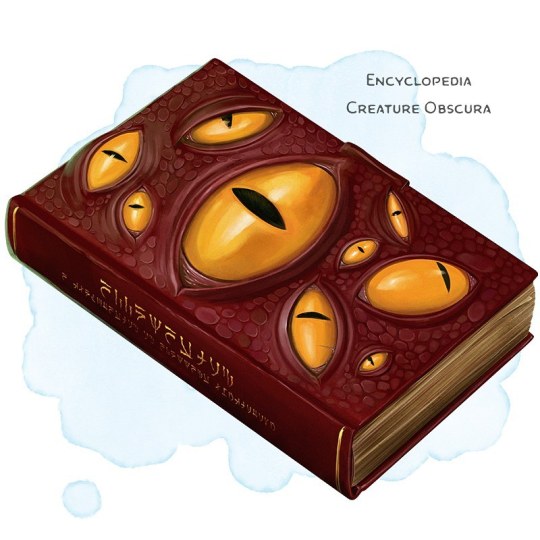
💎 𝗡𝗲𝘄 𝗶𝘁𝗲𝗺! Encyclopedia Creature Obscura
Wondrous item, rare ___ There are fourteen unique entries in this classic, hard-to-find series of encyclopedic tomes, which were originally written by renowned hunters and archdruids. When found, roll a d20 or choose from the table below to determine which encyclopedic volume it is. If you have at least 5 levels in the ranger class and spend 48 hours over a period of 6 days or fewer studying the book’s contents and practicing its guidelines, you gain the favored enemy and language (or similar effect) associated with your volume of the encyclopedia. If you have 5 or more levels in the druid class and spend that same time reading it, you can use an action to expend 2 uses of your Wild Shape to transform into the volume’s associated Wild Shape option or cast the listed spell. A benefit gained from the book is permanent. | 1 | Aberration: A Speculation on Aberrant Physiology | Aberrations; Deep Speech | Gibbering Mouther |
| 2 | Beast: Wild Beasts and Their Domestication | Beasts; beasts can understand the meaning of your words, though you have no special ability to understand them in return | Giant Scorpion |
| 3 | Celestial: The Divinity of Celestials, a Testament | Celestials; Celestial | Pegasus |
| 4 | Constructs: The Inner Workings of Automatons | Constructs; your choice of language | Rug of Smothering |
| 5 | Dragon: The Draconomicon | Dragons; Draconic | Gold Dragon Wyrmling |
| 6 | Elemental: Fire and Water, a Primordial Project | Elementals; Primordial | Gargoyle |
| 7 | Fey: An Interpretation of Fey Minds | Fey; Sylvan | Dryad |
| 8 | Fiend: A Transcript of Fiendish Habits | Fiends; Abyssal or Infernal | Hell Hound |
| 9 | Giant: A Documentation of Giant Culture | Giants; Giant | Ogre |
| 10 | Humanoid: A Study of Humanoid Behavior | Humanoids (any two races); your choice of language | You cast the "alter self" spell (no concentration required) | ... Continued in the comment below! ___ ✨ Patrons get huge perks! Access this and hundreds of other item cards, art files, and compendium entries when you support The Griffon's Saddlebag on Patreon for less than $10 a month!
279 notes
·
View notes
Text
when robots got muscles
You can blame @centrally-unplanned for this post. She(?) wrote...
The ‘chrome’ designs pioneered by illustrators like Hajime Sorayama (Sexy Robot from 1984, for example) tended to be more in vogue at this time (or just…a hot girl, who is apparently a robot, trust me bro), you don’t see designs like this too commonly until later (ask resident robo-fetishist/animator expert @canmom for details on that timeline).
After a challenge like that how can I refuse? Although the question is ‘when did robots get muscles’, this turned into something of a historical survey of robot designs from the 80s on with a throughline of biomimesis.
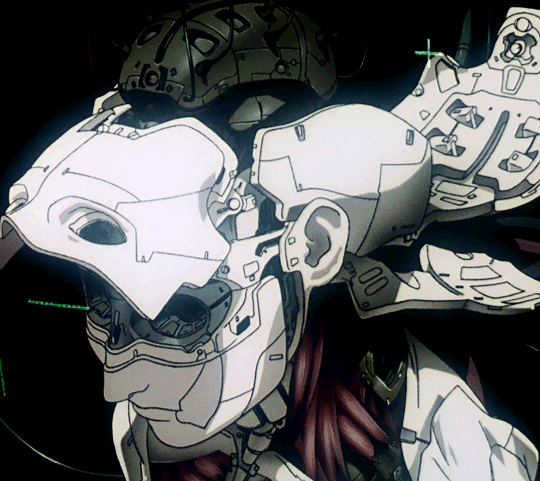
(Originally this was just going to be an excuse to talk about Ghost in the Shell... but I gotta be thorough.)
This was all brought on from this picture from a 1989 fanart magazine...
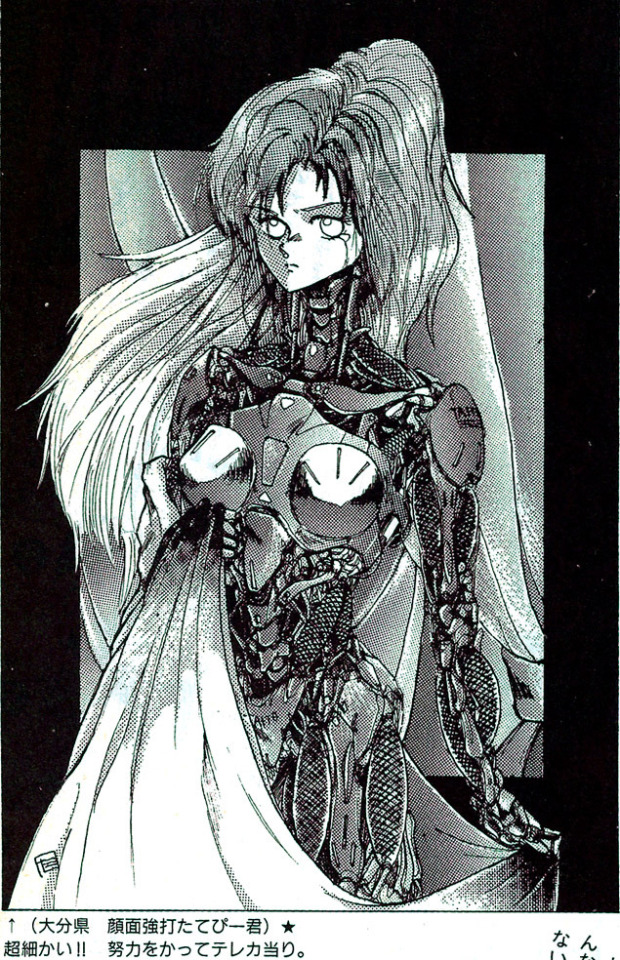
by an artist going by ‘Facepunch Tatebi-kun’ (顔面強打たてびー君, Ganmenkyouda Tatebii-kun). I remarked that it was interesting to see these kinds of ‘robot muscles’ in a picture from 1989, since I thought that kind of design became popular in the 2000s.
On some reflection, I think I gotta revise that opinion! I think ‘robot muscles’ became a thing around the mid 90s in anime; in the West I think it took a bit longer. But you can also see precursors already before that.
So. One thing artists are super into is biomimetic robots. That is, robots whose form (and perhaps function) is similar to animals, especially humans. The word ‘android’ referring to a human-like automaton dates all the way back to the late 19th century, but the modern ‘android, robot, cyborg’ taxonomy apparently became established around the 40s.
There’s two types of humanoid robot that get a lot of play, especially in anime. One is the convincingly humanlike cyborg, which is the same size and shape as a normal human; the other is a what we call in English a ‘mech’, i.e. a big robot you can sit inside.
Of course, if your androids just act like humans all the time, then there’s not much point having them be robots. To really create the frisson of contrast between human and mechanical forms you have to show the mechanism somehow. This could be because the machine isn’t perfectly human-like, and has visibly mechanical joints - take a look at the works of @sukabu89 for very inventive depiction of this theme - or, the android could be damaged or undergo maintenance.
When you attempt to translate biological forms into a more mechanical design language, the traditional way has been to use hard, rigid shapes, since these make the contrast especially clear. In more recent designs, particularly as we started to see real robots with ‘artificial muscles’ such as the ones created by Boston Dynamics, we get another sort of design language to express ‘mechanical parts’, and robots start having more biological forms with exposed plasticy muscles.
So let’s tell the story. We begin at the end of the 70s.
the dawn of mechaguro
For an early example of ‘mechaguro’ (a term I’m applying very anachronistically!), when a robot gets smashed up, we have Alien (1979). This film did a ridiculous amount to define sci-fi design language, and of course the alien itself blends mechanical and biological forms, with its glossy black surface allowing it to seem to melt into the exposed pipes of the spaceship. But let’s focus on the character Ash, a secret android who is broken apart in the second half of the film.

When Ash is torn apart by the alien, his insides consist of weird white plastic beads and a milky fluid that seems analogous to blood. It’s not clear what the function of any of this tech is - it’s intended to be vague and mysterious. The outside is biomimetic but the inside is anything but. He has a kind of artificial skin which resembles a latex mask.
The Terminator films are another major touchpoint for 80s science fiction. Late in the film, Arnie starts taking damage which reveals the Terminator skeleton underneath his fake skin.


The stop-motion Terminator model is basically designed according to the principle of ‘replace human bones and muscles with hard metal bits’. So you have a metal skull, metal clavicles (which are pistons for some reason), metal shoulder blades, hydraulic pistons generally in the places where muscles are. e.g. in the above picture you can see pistons that stand in place of the sternocleidomastoid muscle, and in this picture...

...you can see metal scapulae and piston biceps and triceps and a piston. The shoulder joint by contrast built in a very non-human-like way. Also there’s random tubes everywhere lol.
That’s generally how androids are portrayed in the 80s. The ‘droids’ in Star Wars are similar; C-3PO is an arrangement of metal plates with gaps suggestive of underlying mechanical details and rudimentary joints and pistons.
In Blade Runner, we have the Replicants, humanoid robots - but by the premise of the film, they are essentially indistinguishable from humans. So when the Replicants die, we never really get to see their robo-innards.
and now, anime
OK, that’s the big four Western 80s sci-fi movie series; what of anime? Of course, androids in anime go all the way back to Astro Boy. But most of these early designs don’t really focus on mechanical details all that much. Super robot designs are more like tokusatsu suits than anything. There were certainly instances of impressive mechanical animation in the 70s, with early experts including Kazuhide Tomonaga on Space Battleship Yamato. Then there’s Hayao Miyazaki’s episodes of Lupin III Part 2 which featured proto-Nausicaa flying a prototype of the robots from Castle in the Sky. It would be some years before anyone could come close to matching these!
The original Gundam in ‘79 famously started the ��real robot’ movement [Animation Night, so let’s take a brief look at how a Gundam fits together.
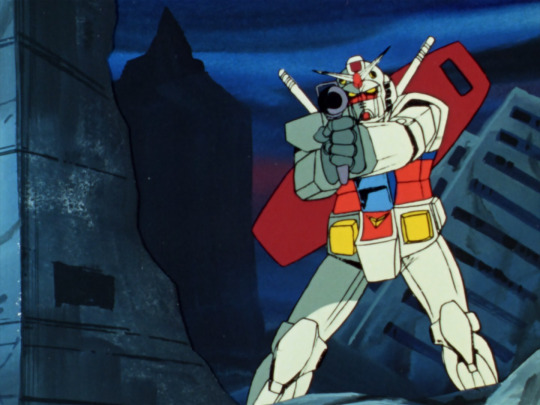
Generally speaking, the way Gundams are drawn in Gundam ‘79 is kind of rough. The methods to animate these rigid mechanical systems in super accurate perspective were just not yet established at the end of the 70s, certainly not on a TV budget. The actual joints on the Gundam are left very vague, but it broadly speaking seems to move like a human in armour.
But the OVA boom was about to begin, and while it would be a while before we saw the heights of Headgear/Production I.G./Gainax, things were going to change a lot. Mechanical design and animation was about to get much more sophisticated very very quickly.
In 1982, we have Super Dimension Fortress Macross, with robots that transformed into fighter jets. Its robots are designed by Kazutaka Miyatake, who cut his teeth doing mechanical design for Space Battleship Yamato and Daicon. The Macross TV series introduced the world to the animation of Ichirō ‘Missile Circus’ Itano. [AN64] A plane with legs... honestly looks kind of goofy, but Itano’s ambition to have a highly mobile 3D camera that could move in ways that would simply be impossible in live action marked a huge step up in how robots are animated. And this would get refined even further in the film Do You Remember Love.
In terms of design, we’re really moving our inspiration from ‘tokusatsu suit’ to ‘military hardware’ here. A Macross suit has to look like something that could transform into a plane, so its silly little arms and legs have to look kind of plane-like. In any case, we are definitely still in a world of hard and rigid robotics.
Dallos (1983-4) dir. Mamoru Oshii is known as the first OVA, if not the first successful OVA [AN115]. It features a variety of mining robots on the surface of the Moon, which are generally less humanoid, taking their design cues from JCBs...

...as well as humanoid robots with fairly clear joint patterns...

...and more humanoid robots too.
The eponymous Dallos, however, is a huge humanoid robot that looks like this...

Here we have a pile of mechanical shapes that vaguely calls to mind a human face. It’s suggestive of motifs we’d see later in works like Akira.
A year later in 1985, Megazone 23 really kicks off the OVA boom in earnest [AN 103]. It also has a robot, in the form of a transforming bike that can become a humanoid piloted mech...
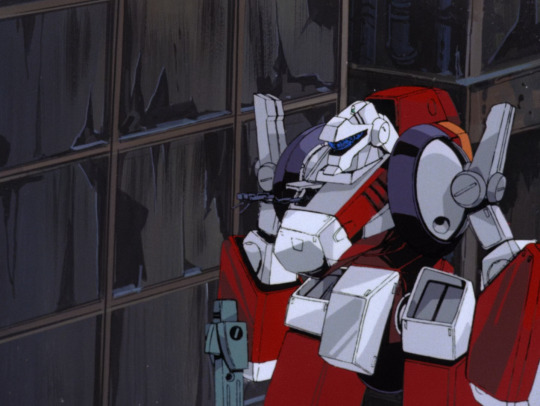
You can see mechanical designs and shading have become considerably more detailed; its motion is a lot more complex as well with a ton of indulgent background animation shots. The actual details of the bike -> robot transformation are rather brushed over. But to sort of sum up the design language: we have organic but hard-edged shapes contrasted by inorganic but round shapes. (These terms ‘organic’ and ‘inorganic’ refer mostly to symmetry and a sense of ‘flow’ in the shape.) There are few right angles as such, but a lot of broadly boxy topology. The shapes are broken up by elaborate specular highlights in complex shapes, a motif of the later Kanada school.
OK, but that’s all variants on ‘rigid robot’ so far - what about the androids? What about the more directly biological designs?
Following the enormous success of Megazone 23 Part I, Toshiki Hirano got the chance to adapt his favourite lesbian cosmic horror hentai manga Fight! Iczer One into a rather more tame OVA which released from 1985-87. In terms of mechanical design, this starts to do some interesting moves towards blending biological and mechanical forms...
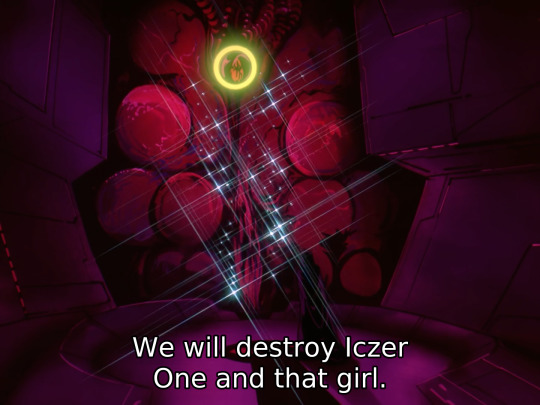
Of course it has a robot in addition to the requisite bishōjo and lightsabers. In contrast to the boxy shapes we’ve seen so far, the robots in Iczer-One have a much more curvy organic sort of design language. Still, there is not a lot of emphasis on the precise details of mechanical articulation outside of select shots. (It is however notable for the first ever Obari punch!)
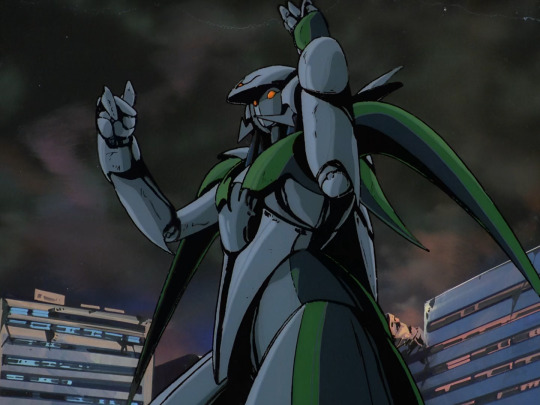
Despite the change in shape language, these are still very clearly animated as metal plates and not yet muscles.
In 1984 we have a very important film (for this narrative, and in general), Nausicaa of the Valley of the Wind, the film that created Studio Ghibli. Here we have the ‘God Warriors’, giant humanoid weapons with the ability to shoot a massive laser out of their mouth. Rather than robots, these are very much biological in nature, having to be grown in a kind of cocoon. In the film version of Nausicaa, an incomplete God Warrior is released, leading to an iconic scene animated by Hideaki Anno in which the God Warrior attempts to blow up the oncoming wave of Ohmu.

The God Warrior’s melting flesh is gorgeously animated, bubbling and sloughing off in great big lumps as the skeleton pokes out from underneath. Throughout, Nausicaa is full of beautiful and impressive animation of both machines (mainly planes) and biological (the giant insects), but the God Warriors, as human-made lifeforms, bring the two together. However, this strand wouldn’t be especially followed up on for a long long time.
Right, but what about Bubblebum Crisis (1987-91)? That is, after all, the iconic 80s robot girl OVA. It’s inspired heavily by Western robot-related films like Terminator and Blade Runner; here we have ‘Boomers’ (never stops being funny) as androids that can appear convincingly human. Like the Terminator, the underlying metal parts can burst out. Here we have a metal frame designed to resemble muscles, and also metal tentacles.
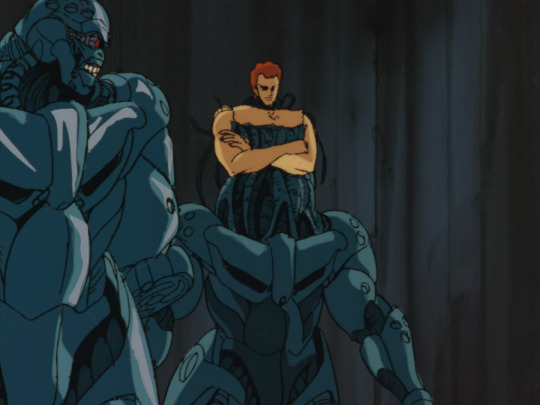
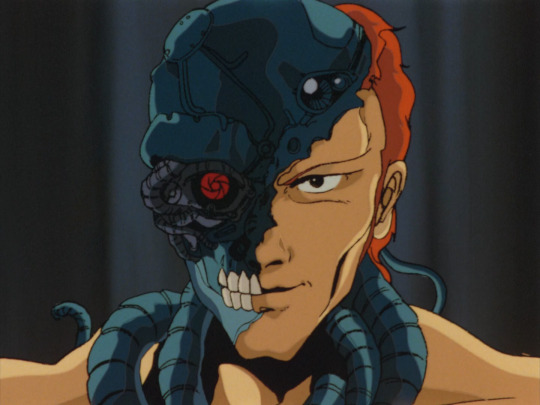
The shapes of these robots are a lot more organic. The robot neck has tubes that sort of resemble the neck muscles, metal plates that resemble pectorals and abs and deltoids and biceps and so on. You’ve even got a direct riff on the Terminator ‘fleshy face falling away to reveal metal skull with glowing red eye’! Under the plates there are clusters of tubes which also heavily resemble muscles. Also you’ve got the classic ‘three small circles’ motif there.
Contrasted against them are the Knight Sabers, who aren’t cyborgs as such but fight in powered exoskeletons which fit the design motifs of robot girls.
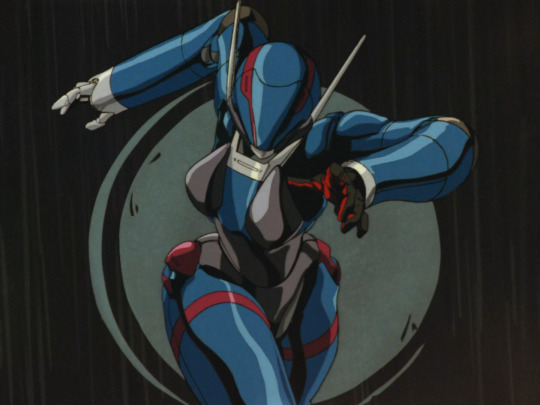
These suits are quite form-fitting, with a rubber under-layer and metal shells on top. There is definitely some attention paid to how they’ll articulate around the joints. One very recognisable 80s motif is the sort of extending spike thingies you can see on her hat there; there’s also the jets that extend out behind the suit. And, you have that multi-layer shiny highlighting of course!
Still, the way the characters move in Bubblegum Crisis is still very squarely Kanada School poses; big movements, lots of held poses accentuated by flashing and line boil, not a lot of concern for conservation of momentum or anything like that.
For a contrasting strand we can look at the rise of the ‘Otomo school’ (if you will) of realism. Around the end of the 80s, a pool of talented animators were gathering around Katsuhiro Otomo. Their most famous work is Akira, but I’m actually going to begin with Robot Carnival (1987), a wonderful anthology of short films from 1987. This features a huge variety of interpretations of the concept of robots.
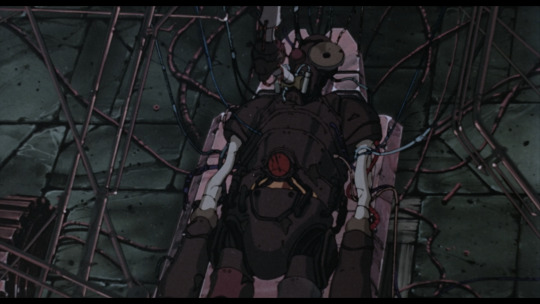
For example, for Kōji Morimoto, later co-founder of Studio 4°C, the robot is a kind of cobbled-together steampunk Frankenstein’s monster. It’s a very cool design with all sorts of asymmetries and exposed parts suggesting its cobbled-together nature. And although all the robot does in this short is stand up and then fall over, a great deal of attention is paid to the little details of its articulation and its movement through space.
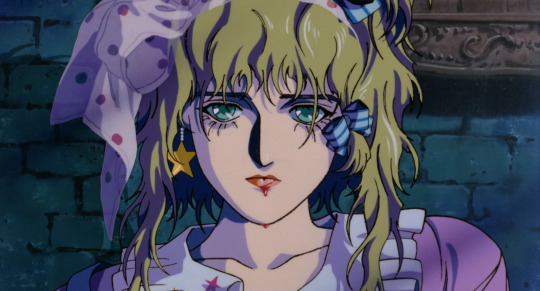
Presence, directed by Yasuomi Umetsu, is notable for its steps in the direction of realism - Umetsu’s characters are hyperdetailed and in some ways over-drawn. The opening shots establish this is a world where lifelike androids are common, when an android gets his head kicked off and stolen by children. Here the robot-as-doll metaphor comes in, something that will be increasingly central in the next decade. The robot girl is essentially a human-sized doll in a room full of other toys. Her creator smashes her to pieces with a wrench; later her ghost visits him as an old man. We see the girl attached to a bunch of wires, but she bleeds like a human.

Cloud by Manabu Ōhashi features another humanoid robot, an Astro Boy-like child recognisable as a robot based on his segmented torso and legs and robotic ear... cones. Here the robot is a standin for human emotions, the boy’s struggles projected onto the constantly changing sky as he walks against the wind.
Strange Tales of Meiji Machine Culture: Westerner’s Invasion by Hiroyuki Kitakubo (later to direct Golden Boy, Roujin Z and Blood: The Last Vampire) is a sendup of mecha shows in which two very goofy looking steampunk robots operated respectively by Japanese and Western crews duke it out, laying waste to the city around them. The Japanese robot is basically a big wooden samurai...
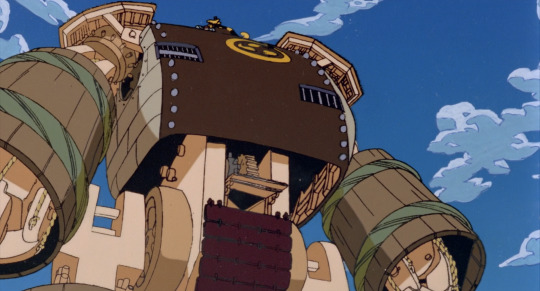
and the Western (more specifically American) robot is, uh
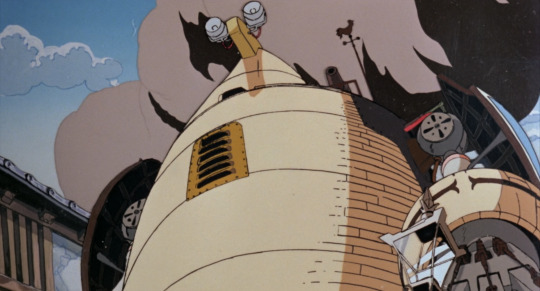
sorta big barrel with little eyes on top? I’m not entirely sure what the deal is with this design!
That’s really not relevant to our story tbh I just think it’s a neat short.
Chicken Man and Red Neck, by Takashi Nakamura, features especially distinctive robot designs. The film is kind of a dream sequence in which a terrified drunk man witnesses the revels of the machines of Tokyo, transformed into robots; the robots are extremely shaped, moving through a world that is pretty much just pistons...
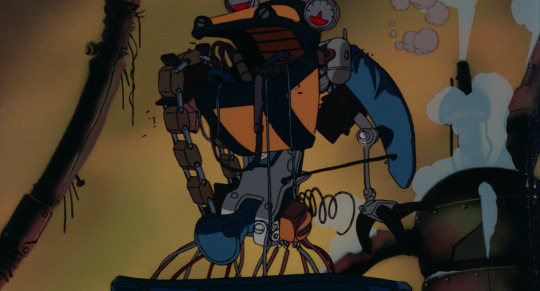
These robots call to mind the dancing demons in Fantasia’s Night On Bald Mountain sequence, or even Bosch.

Otomo’s own segments feature the Robot Carnival itself, a vast mechanical structure built as... well some kind of entertaining spectacle, but which now drives around the post-apocalyptic wasteland dropping robots which explode as bombs. It’s cute.
OK, to wrap up the 80s, we gotta cover Akira (1988) [AN34]! Akira has plenty of impressive mechanical animation of helicopters, hovercraft thingies, satellite lasers and of course the famous bike, but it doesn’t really feature robots as such - but what it does have is a blending of mechanical and biological forms in its climactic sequence where Tetsuo’s psychic powers go out of control. First, wires start to spread like the roots of a plant from his robot arm - less an actual machine and more something he assembled with his psychic powers...
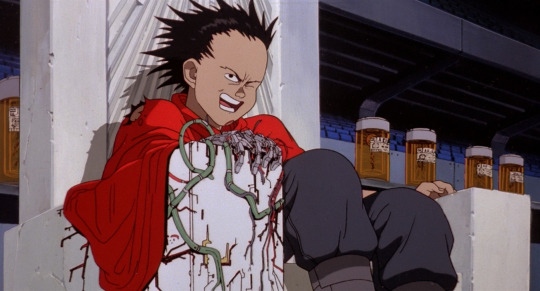
He takes a bullet, and the mechanical wires and muscles start to blend together and spread out like a slime mold...

...which he can extend as essentially a giant tentacle.
When his powers fully go off the rails, he bulges out into big blobs of flesh which have both veins and wires running over them. These burst out of the metallic parts as well.
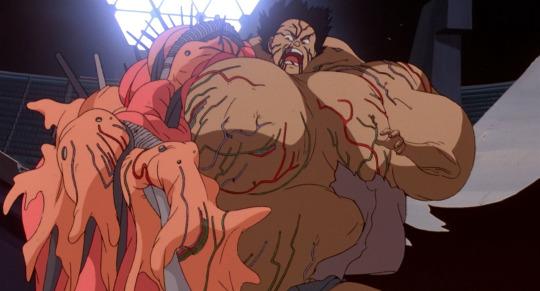
He turns into essentially a giant biomechanical baby.
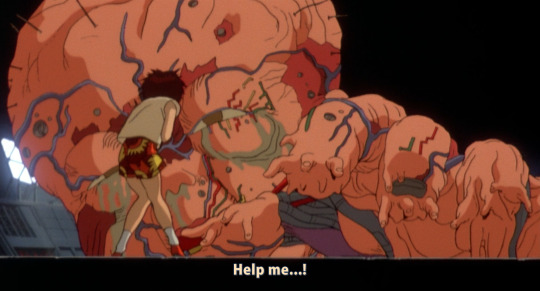
Did Akira invent these images of blending biology and machinery? Probably not, but I’m not really familiar enough with manga of the time to say. What can at least be said is that Otomo’s absurdly meticulous style could really sell it. Otomo was truly a god of perspective and detail; Akira the film was an enormous, prestigious production that threw ludicrous effort and resources towards realising his vision (which doesn’t mean it paid its inbetweeners much more...). A lot of the animators who worked on Akira would go on to be prominent in...
the 1990s
So, the 1990s. If the 80s was dominated by the later Kanada School, the new movement of the 90s, at least as far as film animation goes, was ‘realism’.
But before we get onto that, let’s take a brief look at Gunnm (1990). Known as Battle Angel Alita in the West, this manga by Yukito Kishiro depicts a world in which most people are cyborgs; it was adapted to an OVA by Madhouse in 1993 and became wildly popular overseas. Its protagonist Gally, aka Alita, starts out the story as a wrecked cyborg body like this...
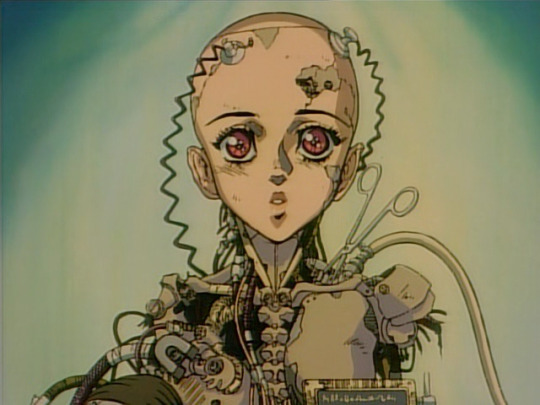
Looking at this design, you can see similar patterns as we have so far. We have metal clavicles, metal sternocleidomastoid muscle, metal pectorals, metal spine. There aren’t robot muscles, per se, but there’s a lot of attention to detail on mimicking biological shapes.
Before long she is rebuilt (twice in the manga, once in the anime). Her new body is like this...

...which is to say a skintight bodysuit in the middle, and metal arms. These arms, although designed in a way that indicates hard surface and with a hinge joint at the elbow, are designed in a way that mimics the flow of muscles in a human arm. By contrast, her sorta-love interest Yugo has a body like this:

which gets mashed to pieces in the finale of the OVA. There’s a striking mechaguro scene in which Gally catches Yugo, but leaves him hanging by a fraying arm, which snaps, leaving him to fall to his death. Compared to later iterations of the ‘robot arm torn apart’ device, this one’s relatively light on detail...
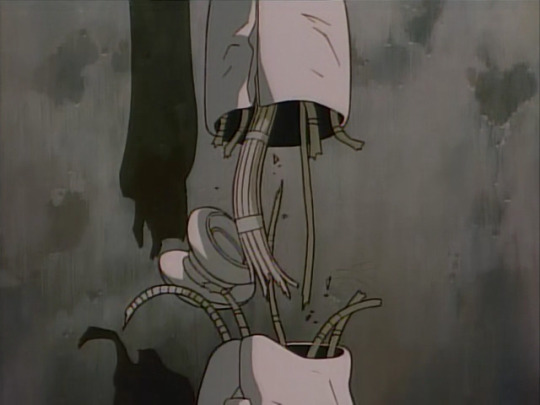
Cyborg bodies in Gunnm are used as a visual indication of character type. Gally has curves but also sleek robo muscles: she’s a Beautiful Fighting Girl, sweet but also extremely powerful. A huge ‘muscular’ cyborg with wide shoulders is likely to be a brute. Yugo here has much more plain, simple shapes with visible bolts, not precision pieces like Gally.
I don’t know how much of this originates with Gunnm. I’m sure the idea of cyborg girls was in the air long before, but this became an influential example on the tail end of the time of the 80s bishōjo. One device that is notable here is the idea of a ‘full body cyborg’, which is only human down to the brain (or perhaps not even that). Body swapping is a major theme in Gunnm, something that would be expanded on before long...
And if that was going out, what was coming in? Let’s look at Patlabor, which traces the evolution of the Headgear artistic collective and IG Tatsunoko into Production I.G.. This is about as down to earth as giant robot stories can get, with robots as just everyday machines used for work and by the cops. But where things really go nuts in animation terms is the opening to Patlabor 2 (1993).
youtube
Here you can see some of the most impressive sequences of mechanical animation ever drawn. We see pilot Noa testing out the robot, and especially notable are the scenes of the hand flexing and of walking. Enormous attention is paid to the articulation of joints. The robot’s hand can swivel 360 degrees, unlike a human; however, like a human, the articulation of the fingers seems to be controlled by hydraulics in the forearm (whereas in humans, the muscles and tendons in the forearm control our fingers). When the robot’s foot steps, it flexes like a real human foot, with believable joints, and a sensible arrangement of pistons to absorb force.
It’s not imitating a human’s muscles, but the attention to the details of the robot’s mechanical design serves precisely to draw our attention to the ways it’s like/unlike a human - the robot’s hand impossible motion immediately contrasted with its pilot shot from the same angle. And the perspective drawing is absolutely impeccable. The robot is made of purely rigid structures, and the way rigid structures articulate is not at all how a human’s joints articulate.
The sequence above was animated by Atsushi Takeuchi. But across the board, the bar was getting pushed for mechanical animation. For example, observe this cut from Mobile Suit Gundam: The 08th MS Team (1996-1999), in which the robot tears off its own arm and beats up another robot. The precision of the way the joints are animated and the way the robots move in space is just completely on another level compared to what Gundam had been doing a couple of decades prior.
Anyway, we’re here to talk about robot muscles, and we’re just a few years out from that now!
The year that robots got muscles, at least as far as anime is concerned, is 1995.
You can probably guess the next part. In 1995, we get Eva and GitS. Let’s start with GitS, to continue the Production I.G./Mamoru Oshii thread. The opening sequence of GitS, animated by - who else could it be? - Hiroyuki Okiura - has to be one of the most iconic segments of video ever drawn. Here’s a merely 720p youtube upload but go and find the place you have GitS stored on your hard drive and watch it in proper quality eh.
youtube
OK, yes, a lot of it is a naked lady floating around, sue me or whatever. But the sense of form. We see early on an appearance of ‘robot muscles’, here closely resembling real muscles...
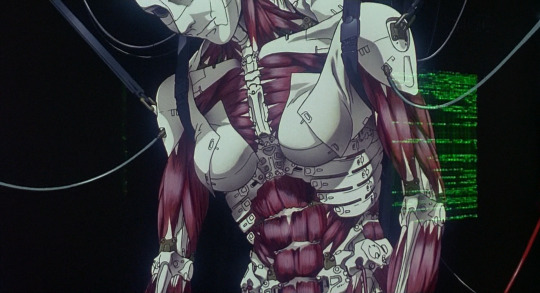
We can see from the way this is drawn that it’s made of a combination of artificial muscles, solid segments, and flexible, fabric-like panels. One of my favourite shots at the beginning shows the solid segments of the skull clicking into place. Here we have a very clear contrast between the angular, hard edges of the mechanical pieces against the organic forms of a human body.
Elsewhere in the film, we see various incredibly cool bits of ‘wouldn’t be fucked up if a body did this‘, like the fingers...
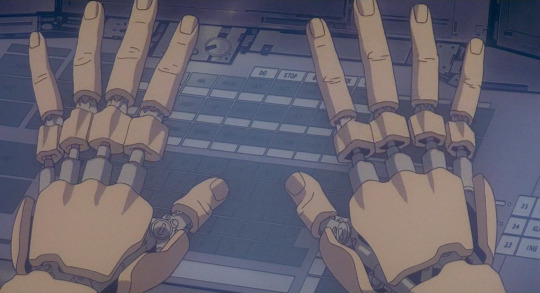
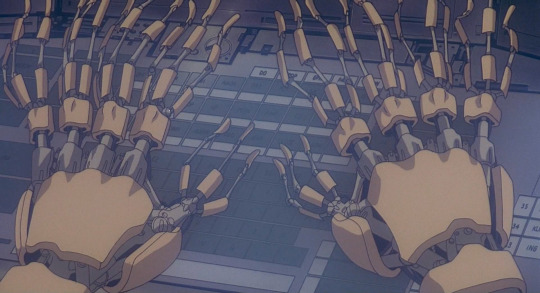
Here, what we expect to be soft biological fingers is contrasted with unexpected rigidity, mechanical joints under a shell.
Also in this scene we encounter a robot body that has been stripped of her arms, legs and hips but is nevertheless still alive...
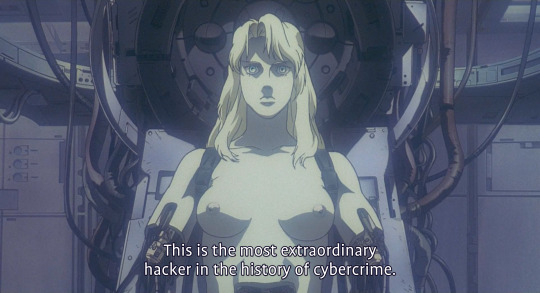

most extraordinary hacker in the history of cybercrime and you have your titties out and yet you still can’t get them to stop misgendering you, smh
For the Terminator, having its body smashed up and continuing to walk was a demonstration of its strength. Here, as would become perhaps an increasing motif, having a robot body is a source of vulnerability: people can do things to you that would kill an ordinary human but you keep going through it. Not surprisingly, ‘robot body maintenance’ is a recurring porn device. (One that GitS deploys in SAC s2).
But of course this all builds up to the all time classics of mechaguro scene at the ending where the Major attempts to tear off the hatch of a spider tank. Muscles ripple individually under the surface of her skin, her arms bulge in exaggerated contraction, and then her arms fully tear apart under the force.
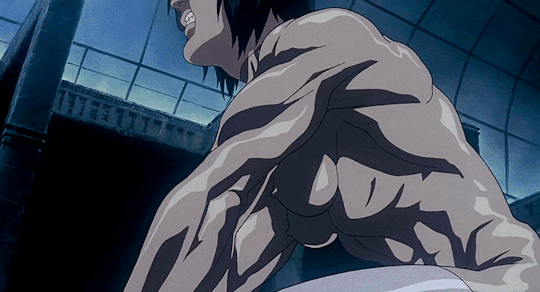
Here, we’re showing her as mechanical not by contrasting rigid forms with biological ones, but by exaggerating the biological ones to the point of doing something extremely unnatural. Human muscles do not generally flex in such an individual way, nor are they strong enough to tear the arm apart, but robot muscles? Yeah, they could do that. This sets up the next scene where the Major lies unnaturally still, but can still exert control through hacking through her union with the Puppet Master.
Robots holding onto something so hard their arms explode has become... if not a recurring image, then at least one that was called back decades later in Violet Evergarden.
The final scene of GitS brings back the image of robot-as-doll, with the Major’s consciousness now uploaded into a black-market robot body that resembles a child in a dress.

This is further expounded on in Oshii’s second GitS movie Innocence (2004), with its Ballade of the Puppets in the soundtrack as Batou and Togusa (and eventually, the Major) are attacked by essentially an army of ball-jointed doll gynoids. The puppets’ movements are extremely unnatural and erratic acrobatics, constantly flipping all over the place; when hit by bullets, panels pop open to reveal the underlying brass skeleton. It’s a very cool image. (The thing that lets the sequence down is the extremely dated CGI and aggressive digital compositing.)
It also has Donna Harraway as a literal cyborg!
Now, the GitS movies didn’t drop fully formed out of nowhere, but draw on the work of Masamune Shirow. The manga has a somewhat different design sensibility than the movie, distinctive and shiny as all Shirow’s art. It is more rounded and organic, less cold.
So, the basic design of a cyberbody originates with Shirow. You can see it on this page (unfortunately from a flipped version, translation Dark Horse):
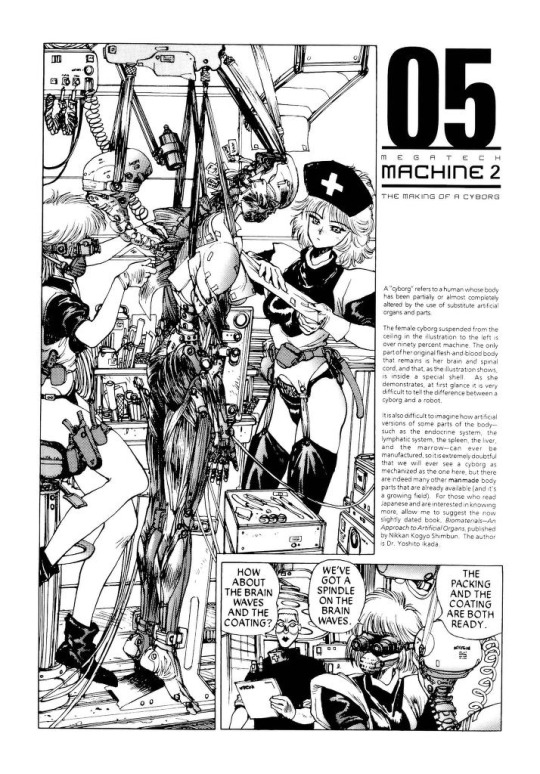
You might be able to determine from how the nurses are dressed that, yeah, the GitS manga is in significant part fetish porn. But really nerdy fetish porn, which is the best kind. This chapter is almost entirely dedicated to explaining how cyborg bodies are constructed in great detail, from the ‘sensory film’ (that’s what’s being applied in the opening to the 1995 film) to the hair implantation.
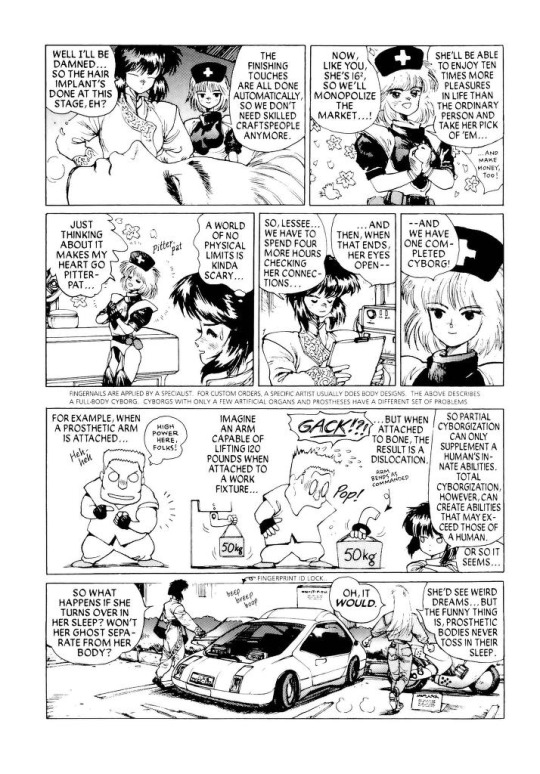
It’s interesting seeing how some of the more out-there designs of the manga, like Chief Aramaki, are transformed into the realist style of Hiroyuki Okiura. It’s Okiura, so it works great of course.
I don’t know if there are manga examples of such detail about cyborg bodies that predate Shirow.
Anyway, that’s just one of the two punches dropped in 1995. The other is Neon Genesis Evangelion. To the pedants: sure, the Evas are not actually robots, but they’re giant cyborgs that play the role of ‘robot’ in the story and they look like robots so I’m counting them.
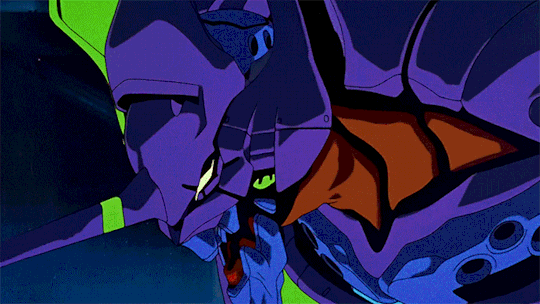
Anyway, the thing about the Evas is they are incredibly lithe. They run, rip and tear and swing heavy objects around in a way that’s both weighty and distinctly biological. Their bodies are extremely flexible compared to prior mechs (look at how much the spines bend in that Iso cut from EoE!), but not without hard, rigid components such as the shoulder towers. Their jaws are bestial but feature mechanical-like components like interlocking hexagonal teeth and jet-like vents. They are in short a fantastic design that blends biological and mechanical features.
The impact of Eva on just about everything can’t be overstated, but as far as robot design, well. There certainly were works that leaned on the precedent set by Eva, as for example RahXephon, which also treats robots as something spiritual, prone to popping into a blob of weird little bubbles just like in Eva.
There’s a great deal missing from this account. I am very focused on anime because I’ve watched a lot more anime than I’ve read manga or played games from this period. So I’m sure there’s major foundational works I’m missing here!
the 2000s
When did the West start to catch up? eh that’s subjective - David Cronenberg was way ahead of the game! - but specifically in the sense of robots with mechanical muscles, I think the major points in the timeline go a bit like this.
In 1999, there’s the Matrix, which leans heavily on anime. This features a similar ‘robot takeover’ premise to Terminator, but here it’s biomimetic robots modelled after squids, with clouds of constantly moving tentacles that sweep behind them. After making a cool half a billion dollars, the Wachowskis decided to pay all their favourite anime directors to make short films. I’m not going to comment on every part of the Animatrix, since most of it isn’t really relevant, but I will point to this horrifying cut by Takeshi Honda in The Second Renaissance in which a robot woman has her clothes torn and then skin bashed off by a mob. The framing, motion, her expression of abject terror, and the ‘reveal’ of her ‘true’ nature, all viscerally call to mind a trans bashing.
On the manga side, a big one to mention is Gantz, a gory nihilistic seinen manga which ran from 2000-2013. The characters in Gantz fight in special latex-like suits which take on the appearance of muscles while engaging superstrength, but can also sustain damage that causes them to drip fluids from ports located at the neck and become fatal to their wearer. Gantz was adapted to anime by Ichirō Itano in 2004, but I haven’t seen it so I can’t comment on any notable animation.
Cyborgs are a favourite subject of games, but in the 2000s, games are really pushing art direction and biopunk stuff is in. Half Life 2 (2004) has its spider-crab like Striders and dropships and so on. Oddworld: Abe’s Oddysee (1997) bases its whole concept around the sheer variety of weird creatures that would inhabit its dystopian factory. And I gotta give a shoutout to Septerra Core (1999) - in case one other person has played that lmao
At some point after 2005, Boston Dynamics became a viral sensation thanks to their robot BigDog. BigDog is just welded steel and hydraulics, but its lifelike hopping movement style definitely brought to mind the idea that the future of robots is going to be in biomimesis.
So, 2007, here comes Crysis to melt your PC! This is an FPS with the not-uncommon premise of being a supersoldier fighting (country America hates) and also aliens, but its gimmick was that you have a special exosuit that wraps around your body with artificial muscles, making you much stronger and manlier or whatever.
youtube
This is indicated by a visualisation that could be right out of a toothpaste ad, where tiny little balls drop into the character’s pores and somehow go straight into the bloodstream which is of course a void full of flying red blood cells. And so on. It sold the game, though! The ad there focuses almost entirely on the suit and not the character wearing it, who is basically an irrelevant soldier man. What it entailed in gameplay terms is that you have a mode switcher so you can have strength or armour or invisibility or whatever. But it’s cool military superscience, you see!
Anyway. Not like my preferred flavour of cyborg is any less stupid I guess x3
In the same year, Bayformers started. These films’ robots are honestly just visual noise, there’s so many moving metal shards going every which way that it’s next to impossible to discern any sort of underlying mechanical principle. A similar ‘overwhelming business’ visual effect would be applied the next year in Iron Man, kicking off the MCU. So mechanical muscles definitely weren’t the only expression of ‘hyper-advanced robot’ in Western visual media in the late 2000s.
I’m going to end my story with two more games: Horizon Zero Dawn and NieR Automata.
Horizon features a world inhabited by a large variety of robot animals, using the peak of AAA rendering techniques. The robots are designed to be biomimetic after both modern animals and prehistoric ones, and feature a combination of hard surfaces and softer biological muscles. For example, a robot horse:
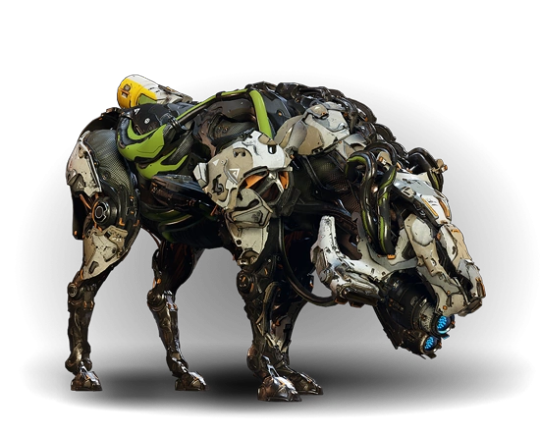
The discipline of making designs like these now has a name: it’s called ‘hard surface modelling’ and it involves boolean operations and bevels and other techniques designed to create a balance of hard edges on a surface against the smoother parts. The design language of Horizon says that the hard plates are white, the soft parts are very dark and may be patterned like a cloth texture, and there can be small colour accents here and there.
I think you can definitely see the influence of Boston Dynamics’s robots (and recent military tech in general) in these designs, iterated on through a decade and a half of increasingly intra-referential concept art. They are visually very busy designs, but there are a couple of recognisable features that draw attention by being inorganic, such as the cylindrical fuel tank at the back. Vitally, the silhouette is very readable.

This robot T. rex for comparison serves as a world boss monster, and you can see it’s got a bunch of military looking attachments that look like radars and missile launchers and so on. As real tech evolved, so too did our idea of what a scary robot ought to look like.
So, that’s where this kind of design pattern has gone in mainstream games.
Now to finish, a brief comment on NieR Automata. Its designs draw hard on those of Ghost in the Shell. Visually it draws a strong contrast between the Machine Lifeforms, who have inorganic shapes (spheres and cylinders) and very visible and plausible mechanical joints, and the doll-like androids, who might as well be human (although A2 provides some contrast in an android who is damaged enough for the underlying materials to show through). The mechanical nature of the androids is communicated by the acrobatic way they move and the interface elements, and dead androids you find in the field - and later when they start losing arms and stuff, it’s a whole thing. But just like humans in Yoko Taro Games, they’re capable of dying in a puddle of blood.
(I guess if you take one thing from this post it’s that if you’re a robot, don’t expect to keep your arms.)
Robot muscles gives you a chance to give both the ‘anatomy porn’ of drawing something very precisely right, with the added bonus of giving you a reason to draw the muscles écorché, and the chance to make it weird and defamiliarised by splitting it with mechanical elements. In short... they look cool!
In this whole post I’ve basically not touched at all on illustration. I can point to a variety of illustrations of robot girls, but in terms of periodising them, I just don’t think I know enough. Though it’s safe to say that cyborg bodies in various states of construction or disrepair are now a mainstream of concept art - and that Ghost in the Shell is usually cited as an influence. I don’t know if robot muscles ever truly became the mainstream way to depict a robot, but it does feel like they’re increasingly common.
One artist I will briefly mention (besides sukabu), mostly bc I think they’re neat, is Haruyo Megurimu, who draws these very intricate designs of ‘necrotech’ which is sort of very biological robots extending out of human bodies - limbs extended on long spindly insectoid strands, jaws splitting open, that kinda thing. Can’t say who influenced them or anything but it’s a compelling extension of the idea into a particular corner of aesthetic space.
And that’s all I’ve got I think. There’s definitely big gaps like. More recent sci-movies. Western comics. Nevertheless, that’s an arc.
If you’ve read this far: thank you for indulging my autism.
788 notes
·
View notes
Text
subspecies below the cut:
Human:
Sapiens: Bog-standard human.
Neanderthalis: Stockier and more resilient to the cold.
Erectus: More archaic, may have been covered in hair.
Dwarf:
Mountain: Classic miners and brewers.
Cave: Deeper-living, may have chitinous shells or fly-like wings.
Abyss: Very similar to the maggots that one ate Ymir, may have additional limbs and lack eyes.
Elf:
High: Long-limbed and graceful, your usual depiction of elves.
Ork: Green-skinned and strong, with impressive tusks.
Wood: As beautiful as the High Elves, but more mysterious. Probably forest-dwellers.
Gnome:
House: Regular gnome, lives in a hole.
Hill: Less magical and more lucky.
Goblin: Bat-like and green-skinned, with poor eyesight and flat, leaf-like noses.
Reptilian:
Lizard: Scaley and swamp-living, your typical lizard persin.
Draconic: Small and mischievous, they appear similar to the dragons they worship.
Carnal: Quick-footed and carnivorous, they usually have feathers and claws.
Felinid:
Felis: Typical anthropomorphic cat.
Panthera: Larger, stealthier, akin to Orks compared to High Elves.
Homo: Less cat-like, more like a human with cat-like features such as ears and a tail.
Automaton:
Steam: Clockwork mechanics and steam-driven pistons, your good ol' robot man.
Ushabti: Former servants, these men of clay are animated not by machines, but by magic.
Marionette: A puppet brought to life, whether that be internal mechanisms in your wooden hull or through a fairy's gift.
Undead:
Putrid: Whether skeletal or zombified, this is a resurrected corpse.
Patchwork: Formed of many pieces, these promethean creations search for their long-lost creator.
Vampire: Blood-starved, sunlight-loathing, you know what this is.
Star-Spawn:
Cthonic: Squid-faced aliens from beyond the stars, they best exemplify the Star Spawn.
Rural: More humanoid than others, you can blend in with others as long as your full body is not revealed.
Amoeba: The most shapeless of all, you're more or less a sentient mass of protoplasmic jelly.
Elemental:
Solid: A being of animate Earth, sand, stone, glass, ice, and steel.
Liquid: A being of animate Water, Mercury, magma, and other juices.
Gas: A being of animate Air, Fire, hydrogen, steam, and dust.
444 notes
·
View notes
Text

On the left, the wererat! They're clever, people sized, and incredibly dexterous. They can also choose between their original form of a normal person, a giant rat, and a rat person hybrid form that's a bit shorter than their normal form. They're also very social, and actually prefer to mate with uninfected humanoids like (probably) you! There is a tail in the hybrid form btw, just hidden in a pant leg I guess.
On the right is the animated armor! The average one is platemail and simply follows your commands to the letter. However, they CAN be made of any armor if you'd prefer leather, and there are apparently even rare ones that can hold full conversations instead of scripted words! So I guess most are automatons, but some are actually sentient.
191 notes
·
View notes
Text
hades!wriothesley's constellation is cerberus, yes, but he also has a gardemek that takes the form of a massive three-headed dog. the thing sits motionless in front of his office seemingly powered off, but rumor has it that it roams the corridors of the fortress of meropide after midnight. the mechanical beast grows aggressive during the witching hour, although hades himself will often dismiss the rumors, saying that it is merely attending to unwanted guests.
as a matter of fact, what if he has several cerberus gardemeks? amongst the ranks of the gardemeks that lie in wait in their designated stations, there is also a cerberus mech on each level -- maybe two or three per level, each spaced out so as to maintain order and have all bases covered. when they walk, one can hear each and every one of their mechanisms clicking and turning. each step rocks the very ground they walk upon; a few prisoners (residents as wriothesley would probably correct you) have expressed their concern that a cerberus mech could end up drowning them all some day. of course those are just the ramblings of a paranoid prisoner (resident), but their worries aren't unfounded.
the very first time you tried to enter wriothesley's office, the cerberus gardemek stationed there nearly ripped you apart.
you're too terrified to even think to say the words that wriothesley told you to say when prompted. the gardemek spoke to you just moments earlier, the automated voice commanding you to state your name and business. you weren't aware that you were being timed either, so when you stutter one too many times and take too long to answer, the hulking automaton shifted its stance into that of a predator hunting its prey. it planted its front paws on the ground and lowered itself with its hind legs in the air. if this were a smaller, more... organic dog, it would've been mildly threatening at best. but this? this was menacing. you were not staring down at a dog that you could hide from -- you were being watched by death itself.
state your name and business, the beast warned you. you could hear the hiss of the joints in the jaw moving as it opened its mouth to reveal its silver serrated teeth. unlike the polished, humanoid gardemeks elsewhere in the fortress, the teeth seemed... dirty. rusted, even. your body went cold with the realization that it was likely dried blood.
your mouth opened to answer the question, but no sound came out. your head was a mess. if you don't answer the question, will your blood stain the once-silvery mass of teeth in this monster's mouth? you glanced at the floor briefly and saw that sure enough, the floor was a different color beneath your feet than it was anywhere else -- as if someone had done some intense scrubbing. you held your breath.
by this point, you were too terrified to provide the answer that the mech was asking you for. you briefly considered fighting your way out of this, but you can't take this thing on alone. a few armed gardemeks, maybe, but not something this massive. so, you squeezed your eyes shut when you heard the mech utter the words, "time has run out. eliminating intruder."
aaaand then i stopped writing because i'm falling asleep. obviously you don't die, but you get what i'm trying to say, right? right.
165 notes
·
View notes
Text
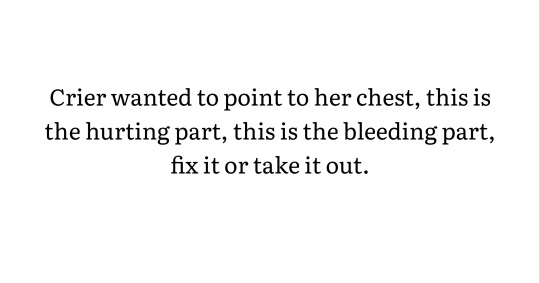
– Nina Varela, Crier's War
#book quote of the day#nina varela#criers war#enemies to lovers#revenge#sapphic#wlw romance#heartwarming#great character development#in love with the cover#fantasy#high fantasy#ya#romance#humanoid automatons#pride month#book quotes
24 notes
·
View notes
Text
It’s better late than never, amiright?
Nobody asked for it, but here it is anyway. The prompt list for 2024’s Monster March!

The collection for Monster March can be found here! There aren’t many rules, but please give them a look over. The collection will be open starting today, but works won’t be accepted until March 1st. I’m so excited to see what everyone will do!
Plaintext list under the cut
1. Robot/Android/Cyborg/Automaton
2. Dragon
3. Extradimensional Being
4. Humanoid Animal (i.e. Tabaxi, Kenku, Dragonborn)
5. Taurs (i.e. Cervitaur, Centaur)
6. Doppelgänger
7. Succubus/Incubus/Concubus
8. Undead (i.e. Lich, Frankenstein’s Monster)
9. Pixie/Fairy
10. Fae
11. Angel
12. Naga/Lamia
13. Vampire
14. Minotaur
15. Slimeperson
16. Djinn/elemental spirit
17. Ghost/Spirit
18. Merperson
19. Demon
20. Alien
21. Shapeshifter
22. Alraune
23. Werewolf
24. Satyr
25. Harpy
26. Drider
27. Giant
28. Cryptid
29. Sphinx
30. Forest Spirit
31. Free Day
93 notes
·
View notes
Text
Snippet #3
As promised, here's a small snippet from chapter 1. Please note that it's not completely edited and that wording and content might change in the final draft.
There are three different flavor-text options here depending on the background you've chosen for your MC at the beginning. These are going to pop up a lot throughout chapter one. I decided to include all three of them in this excerpt to give a small look at how they differ from one another.
Aristocrat = A noble upbringing in the capital.
Nomad = A childhood spent with a community that moves from place to place.
Scavenger = The MC was the only child in a ragtag group who search for discarded items to sell.
Enjoy!
“You must be famished,” Cirern stated, not bothering to phrase his words as an inquiry. “Allow me.”
With one swift motion, he gave a quick and quiet snap of his fingers. You waited silently, expecting something to happen. Seconds passed, but the man did not stir again. Though hunger gnawed at your stomach, rendering you tired and weak, you couldn’t help but to wonder whether he was somehow testing you.
You didn’t take note of the faint whirring at first. It wasn’t until it grew into a discernible noise that you turned your head to the side, perplexedly regarding your surroundings. Unable to hold yourself back, you let out a gasp as your eyes found the source of the odd, intrusive sound.
A figure had appeared by one of the room’s openings, though it was no being of flesh and bone. Matted gold clad the figure, reminiscent of armour rather than skin. Cogwheels turned inside of its exposed chest, methodically and cooperatively. The face resembled that of a human, but where a person would have eyes, two hallowed holes stared back. A straight nose and curved, metallic lips completed the face, but you weren’t certain whether the attempt at making it pass as something humanoid made the sight more or less unnerving.
Aristocrat: You knew of these creations, though you had never laid eyes on one other than the drawings included in books. "Automatons" they were called, artificial life created from clockwork, originally hailing from Ciralor to the south.
Scavenger: You had witnessed these types of creations in the past, though never one made in the image of a person and never one that hadn’t long since stopped operating. Scraps of metal here and there, most commonly. If your memory served you correctly, they originated from Ciralor to the south.
Nomad: You swallowed, mesmerized by – or struck with fear of – the strange creature.
“An automaton,” said the man to you in an explanatory fashion. “A machine built to serve mortal men. It will cause us no harm.”
The automaton’s movements were stale and jerking, lacking the natural grace that organic beings possessed. Yet it advanced across the room, towards you, without noticeable difficulty."
54 notes
·
View notes
Text
I really am curious what the story is on the robots in Helldivers 2. The symbol of the Helldivers is a stylized human skull, seen on their banners and armor, and the automatons also adorn themself with (actual) skulls.
They adhere to anthropomorphic design with humanoid body shapes, vehicles intended for a pilot, and their most important vital functions and eyes are housed in the head, which is again made to resemble a human skull.
Their camps, which are typically just tactical facilities like fabricators, fuel depots, and jamming stations, with defensive emplacements are often outfitted with assembly lines dedicated to dismantling the collected bodies of slain humans (usually Helldivers). These human remains are then used to adorn the robot facilities and the machines themselves, with polished skulls decorating larger automatons and carved up corpses impaled on spikes placed near entrances to their camps. They also fly flags and banners with their own symbol, a 5 pointed star.
Grisly as it all is, it doesn't seem alien. One of the NPCs on the player ship says she suspects the bots built themselves out of old Super Earth tech, and while it's clearly intended as the game's typical "we are the best and only civilization and the aliens want what we have" militarism, I think she might be closer than she thinks.
It wouldn't surprise me if the automatons were remnants of another human faction, or if human remains were somehow incorporated into their construction.
41 notes
·
View notes
Photo
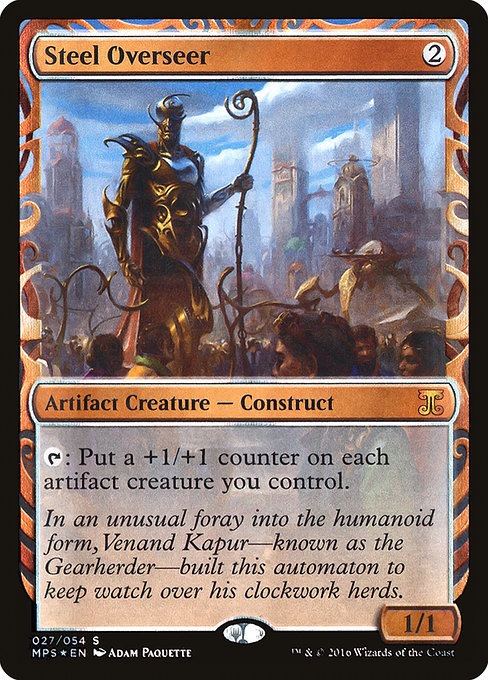
Steel Overseer
In an unusual foray into the humanoid form, Venand Kapur—known as the Gearherder—built this automaton to keep watch over his clockwork herds.
Artist: Adam Paquette
TCG Player Link
Scryfall Link
EDHREC Link
#mtg#magic the gathering#tcg#adam paquette#steel overseer#kaladesh inventions#artifact#creature#construct
24 notes
·
View notes
Text
For Personal Read only, really OOC.
"Let go of Dire right now you bastards!!" You roared toward the STYX's guards that were escorting Crowley, ready to give the automatons a hard kick.
Just before Trein could keep the knocked-down automatons another knock, one had threateningly loomed behind you, ready to bash your head.
But it never did so, not when Crowley's magic had prevented anything from touching you, not even the staffs. "My, my! I have told you gentlemen I'd follow you obediently so why bother my student? I am gracious enough to not scrape you so let them go!"
It took time for the automatons to recompose themselves, alternating to a default mode before Crowley dispersed the magic barrier. "I'll be back so no need to trouble yourself with these gentlemen! See? This is why I've always told you to not act with brawn over brain!" Crowley gave your cheek a playful pinch before turning his heels back, "Professor Trein, I assume you are kind enough to watch them in my absence?"
It was not a question, it was an order.
"Khk-! Meanies! I will find a way to drag you out myself!"
-----
Crowley couldn't find you in the college, not when any of the ravens were able to find you. He had to manage and find which raven was smart enough to tail after you and fortunate was him, a crow managed to sneak into the Island of Woe.
But what was more amusing was the fact that there were 2 ravens that tailed 2 subjects into the island. One resting on your hand while the other was trapped in a cage, observing one of his students.
The other student who belonged in the Ignihyde dorm, sat like an honored guest with tea and desserts lined for them to consume. It appeared that this student had a connection with the Shroud Family, he assumed.
To be fair, he was not assuming. He was merely monologuing like a main character who had no idea of anything.
That student, was 'you'. And he knew you better than anyone would ever be. In summary, that student was a humanoid developed by a certain family and the Shroud family.
Caught in a pitiful state just like Ortho Shroud, the student miraculously survived despite being pronounced dead. It was only a slight chance of living as a human but both families were quick enough to find a way to pull them from the underworld.
It was more of a prisoner in a humanoid body, a prisoner that yearned to die, contrasting Ortho Shroud's wish. Neither of them had the same noble wish but both of them shared a goal. To eradicate the world for a mutual chance of living.
Idia was never fond of you, as he quoted, he found your gaze unsettling. Unsettlingly familiar, similar to the student. But what unsettled him the most was the fact that Ortho was very fond of you just like how he acted with him.
And he hated how his guts seemed to whisper some ominous truth about you and the student who resided in his dorm. Perhaps the trip to the Island of Woe would help ease him down?
------
Vil managed to yank Idia up while you were trying your best to not fall. Alas, it was pointless, a pair of inky hands kept you still by your ankle, legs, thighs, and then to your face.
With the same pair of eyes you two shared, the blot stared into you in disdain and grudge, pulling you deeper into the underworld. What greeted you was not death but a burst of magic.
Just before you could put it to good use, the same raven that stuck around you burst into an army of ravens, circulating around you to the point you couldn't see their eyes anymore. Only darkness enveloped you.
"You must not join us just yet, don't worry, I will console them later"
-------
"Woah, Vil, what happened to you? Did I sleep for another thousand years again?" were your first words the moment you woke up. It couldn't be helped, aside from Lilia's burgundy eyes, Vil was the one who caught most of your attention.
"Silence! You were only asleep for hours!"
"Lilia seemed to enjoy playing the role of a prince when he transferred his magic onto you with his lip." Malleus quoted as he observed everything.
"Pukukuku, how does it feel like to be woken up like a princess?" Lilia gave your cheek another smooch before dropping you on both legs. You were perfectly fine, alive in a youthful appearance.
Magic.
You tried to imagine something, to prove that you were capable of using it but failed miserably. You couldn't wield even one bit.
Ortho Shroud. Idia Shroud. Those two names rang in your head.
They have to know how to regain my power.
Oh if only you turn your suspicion toward Crowley.
31 notes
·
View notes
Text
I've been seeing a lot of "favorite type of creature/entity" polls floating around and I am curious myself so:
#poll#i have always been a sucker for androids and robots#*guestures vaguely to my oc morgan*#shapeshifters too#any characters who push the bounda of how humans define themselves and others really
47 notes
·
View notes